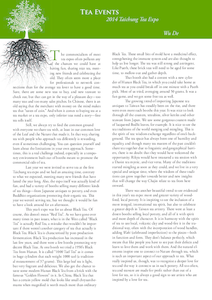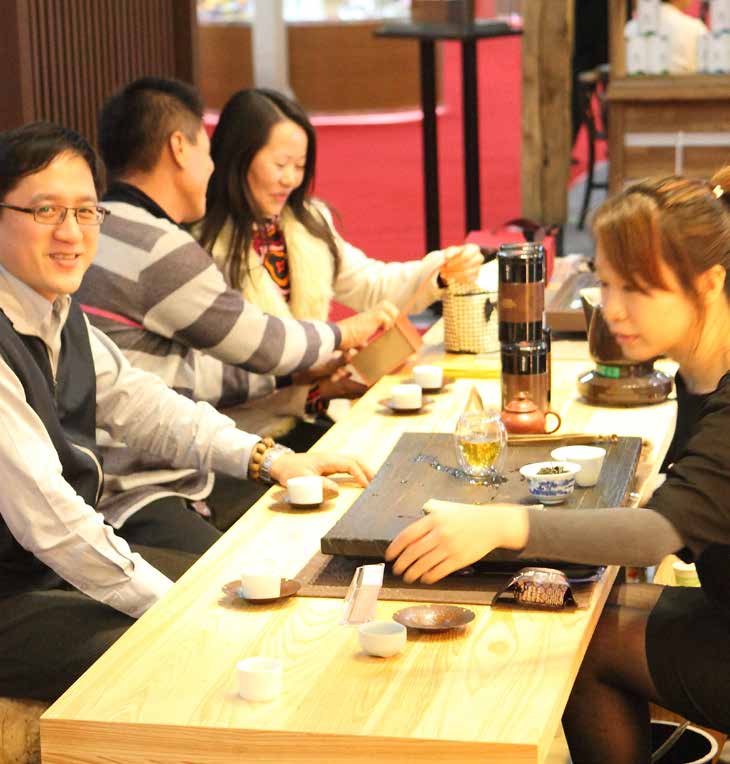
 |
|
The commercialism of most tea expos often pollutes any of the chances we could have at having fun, sharing nice tea, meeting new friends and celebrating the old. They often seem more a place for professionals to network connections than for the average tea lover to have a good time. Sure, there are some new teas to buy, and new teaware to check out, but that can get in the way of a pleasant day - too many teas and too many sales pitches. In Chinese, there is an old saying that the merchant with money on the mind makes tea that "tastes of coin." And when it comes to buying tea at a tea market or a tea expo, only inferior teas need a story - fine tea sells itself.
Still, we always try to find the common ground with everyone we share tea with, at least in our common love of the Leaf and the Nature that made it. In that way, sharing tea with people who approach tea differently is rewarding, even if sometimes challenging. You can question yourself and learn about the limitations in your own approach. Sometimes, this is a real challenge indeed, especially in a temporary environment built out of booths meant to promote the commercial side of tea.

Last year we were invited to serve tea at the first Taichung tea expo and we had an amazing time, contrary to what we expected, meeting many new friends that have lasted the year long. Also, the expo itself was actually kind of fun, and had a variety of booths selling many different kinds of tea things - from Japanese antiques to pottery, and even Buddhist organizations promoting their organic tea. This year we weren't serving tea, but we thought it would be fun to have a look around for an afternoon.
This year's expo was for us about Black Tea. Of course, this doesn't mean "Red Tea". As we have gone over many times in past issues, what is in the West called "Black Tea" is actually Red Tea, a mistake that wouldn't be important if there weren't another category of tea that actually is Black Tea. Black Tea is characterized by post-production fermentation. Black Tea production has increased in the last few years, and there were a few booths promoting very decent Black Teas. At one booth we tried a 1950's Black Tea from Hunan. It is called "1000 Tael Tea" as it comes in huge cylinders that each weight 1000 tael (a traditional measurement of 37 grams). This large leaf tea is light, but very fragrant and delicious. We also got the chance to taste some modern Hunan Black Tea from a brick with the famous "Golden Flowers" in it. In China, Black Tea that has a certain yellow mold that looks like small chrysanthemums when magnified is worth much more than ordinary Black Tea. These small bits of mold have a medicinal effect, strengthening the immune system and are also thought to help us live longer. The tea was still strong and astringent. Like Puerh, these brick teas will need to be aged for some time, to mellow out and gather depth.
That booth also had a contest with a new cylinder of Hunan Black Tea, in which you could take home as much tea as you could break off in one minute with a Puerh pick. Most of us tried, averaging around 50 grams. It was a fun game, and we got some free tea as well.
The growing trend of importing Japanese tea antiques to Taiwan has steadily been on the rise, and there were even more such booths this year. It was nice to look through all the coasters, tetsubins, silver kettles and other teaware from Japan. We saw some gorgeous coasters made of lacquered Bodhi leaves, for example. It is nice to see the tea traditions of the world merging and mingling. This is the spirit of tea: wisdom exchange regardless of one's background. The tea space has always been one of humility and equality, and though many tea masters of the past couldn't share tea together due to linguistic and geographical barriers, there is no doubt that they would have welcomed the opportunity. Rikyu would have treasured a tea session with a Daoist tea mystic, and vice versa. Many of the traditions started mingling as soon as they could, and we live in a very special and unique time, where the wisdom of these traditions can grow together towards better and new insights that will change the way Chajin relate to tea from here onward.

There was another beautiful trend to see evidenced in this year's tea expo: more and greater variety of woodfired, local pottery. It is inspiring to see the inclusion of a more integral, international tea spirit, but also to celebrate a greater depth in Taiwan tea artistry. There were at least a dozen booths selling local pottery, and all of it with spirit and more depth of character. It is in harmony with the spirit of tea to use local, volcanic clay and wood-fire it in the traditional way, often with the incorporation of wood handles, adding Wabi (celebrated imperfection) to the pieces - both in function and form. They don't balance perfectly, which means that like people you have to see past their defects and learn to love them and work with them. And the natural elements inspire one to connect to Nature through tea, which is such an important aspect of our approach to tea. What really inspired us, though, was to recognize a deeper love for tea and the way it connects us in such pottery. All too often, tea and teaware are made for profit rather than out of a love for tea, so it is always a good sign to see artists who are inspired by a love for tea.
Through coming into contact with mainstream tea, tea markets, expos, etc., we are forced to question our tradition, learn new things and focus on ways we can share tea with others who don't approach tea the same way as we do. This is an essential aspect of working with tea. There is far too much tea snobbery in the tea world, as there was in ages past. Rikyu spoke at length about this. The tea spirit is one of sharing and humility. While it is important that we take pride in our brewing methods and approach to tea, we don't have to do so because we think we are better than others, but rather because this is our way - the one handed down to us. If your father handed you down a hammer from your grandfather and it worked well, you would be proud of it because it is your hammer, not because it is better than your neighbor's hammer. Similarly, at the end of the day, we left in gratitude for our approach to tea, and having learned from others' approaches as well. Our aim wasn't to share, but to explore and learn. Our tradition is committed to serving. We need to find the things we share in common with other traditions, to question ourselves regularly and learn new things, staying open and flexible so that we grow together.
We also need to find ways that our tradition can positively influence tea lovers, whether they use our brewing methods or not, and whether they approach tea the way we do or not. Ours is an attitude of service: we have cooked this meal. It is free. You can have some, whether just a tomato or some of every dish. Take as much as you like. Also, should you wish to cook food like us, and share it with others freely like us, we will also teach you our cooking methods. In other words, we practice certain brewing methods and an approach to tea, but you don't have to share our approach or brew tea like us in order to share tea with us, whether we're serving you or you are serving us.
One trend that we would like to see more in mainstream tea expos is a promotion of more sustainable, organic tea farming. No matter what you love about the Leaf, from the catechins and flavonoids to the flavors and aromas, from the peace and presence to the beautiful teapots - whatever you love in these leaves got into them through the stem, the branch, the trunk and roots, sun and earth. How do you love a leaf without loving Nature?

At least in our love for tea we can sit together and share. We all got to cultivate some of this humility, and not a hypocritical humility where we think we are the best tradition because we are the "humble ones" but a true openness to connect and learn from Chajin who approach tea differently than we do. Hopefully, we shared some of our spirit with them as well.
While tea expos still aren't our favorite place to be around tea, we still had a great day. We found some novel teas and made some new friends, and laughed together with a few old ones. One of the highlights of the trip was meeting Mr. Lin Yi San, who so generously donated this month's tea to all of us. His kindness and love of sharing shone through right away, and sharing tea with him was worth the trip alone. When we told him about Global Tea Hut, his eyes lit up and he said, "Sharing is what tea is all about. It's why I do this!" Even in an expo, the spirit of tea shines through!
